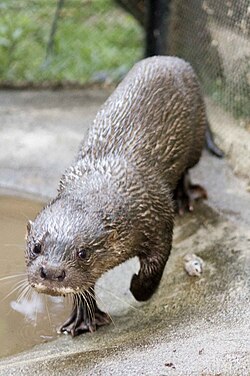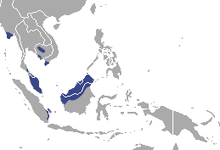Lutra sumatrana
| Hairy-nosed otter | |
|---|---|
 |
|
| Specimen from Cambodia | |
| Scientific classification | |
| Kingdom: | Animalia |
| Phylum: | Chordata |
| Class: | Mammalia |
| Order: | Carnivora |
| Family: | Mustelidae |
| Genus: | Lutra |
| Species: | L. sumatrana |
| Binomial name | |
|
Lutra sumatrana Gray, 1865 |
|
 |
|
| Hairy-nosed otter range | |
The hairy-nosed otter (Lutra sumatrana) is a semiaquatic mammal native to Southeast Asia. It is one of the rarest otter species. Until 1998, it was thought to have been extinct, but small populations have been discovered since then.
The hairy-nosed otter is the least known of the Asian otters, and is also the most difficult to identify in the field. It gets its name from the hairs on the end of its rhinarium (moist part of its nose); in most other respects, it is similar to European otter, Lutra lutra. Hairy-nosed otters are entirely brown, except for lips, chin, and upper throat, which are whitish. Their fur is rather rough but short. Their tails are flattened and oval in cross section, and their feet are fully webbed between the digits, with prominent claws. The penis of the adult male is not visible externally. The contact call between otters is a single-syllabic chirp; adult females call to pups with a staccato chatter. Large otters are very similar and can be positively distinguished only by close inspection of the nose and fur, or the skull. In this species, the skull is flatter than that of smooth otter, Lutrogale perspicillataI and has smaller teeth.
The hairy-nosed otter can be found in coastal areas and on larger inland rivers, solitary or in groups of up to four. Its diet includes fish and crustaceans. Pairing of a male and a female may be limited to the breeding period.
This otter is found in Southeast Asia (Myanmar, South Thailand, Cambodia, South Vietnam and Peninsular Malaysia, including Sumatra and Borneo). Extremely few individuals survive in Vietnam, southern Thailand, Sumatra and Cambodia, being menaced by poaching.
At present, it is believed to live mainly in two nature reserves in Vietnam, in the Toa Daeng peat swamp forest in southern Thailand, and in Sumatra, the place for which it was named. It was rediscovered in 2005. It was also rediscovered in Tonle Sap Lake, Cambodia. Even from these places, they are known from a tiny number of sightings and some roadkill, and from skins.
In June 2008, the Wildlife Alliance-led Wildlife Rapid Rescue Team received a donated hairy-nosed otter originating near the Tonle Sap in Cambodia. Working with Conservation International, they established a safe home for the rescued otter at the Phnom Tamao Wildlife Rescue Centre, but the otter, which had been frequently sick throughout its life in captivity, died of unknown causes in February 2010. Phnom Tamao Wildlife Rescue Centre rescued another hairy-nosed otter in July 2010, and hope it will become part of a future captive breeding program. This is currently the only known hairy-nosed otter in captivity.
...
Wikipedia

